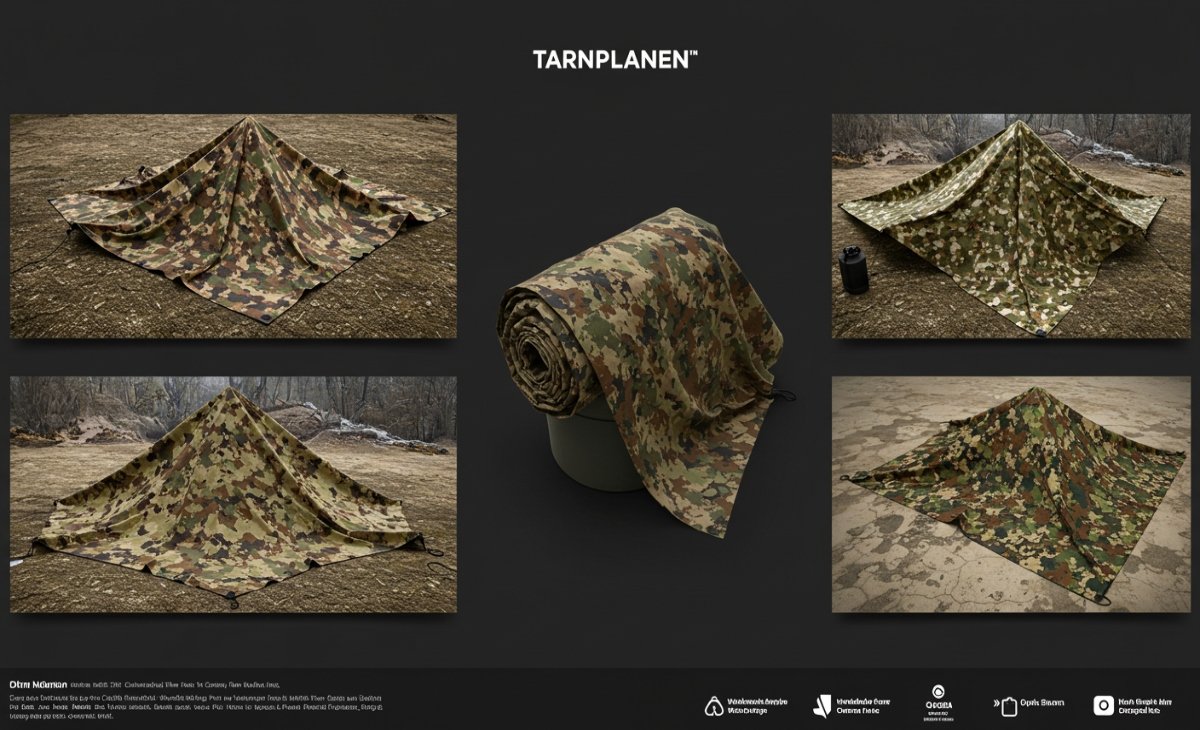The term tarnplanen is derived from the German language, combining two words: “Tarn,” meaning camouflage or concealment, and “Planen,” which refers to tarpaulins or covers. Together, tarnplanen translates to camouflage tarps or camouflage sheets. These rugged and purpose-built sheets are used extensively in military operations, tactical scenarios, and outdoor survival activities. Their main function is to conceal and protect, making them indispensable in harsh environments.
The Purpose and Function of Tarnplanen
Tarnplanen are designed to serve two main functions: concealment and environmental protection. Built with durability and camouflage in mind, these tarps are engineered to blend into various environments while withstanding natural elements like rain, wind, and sun. They are often used to cover equipment, create shelters, and reduce visibility in both rural and urban surroundings.
In military settings, tarnplanen serve to hide equipment such as tents, vehicles, and supplies from enemy view. Their use has now extended to the civilian world, where they are popular among campers, hunters, hikers, and photographers who need practical gear for concealment and shelter.
You Might Also Like: What to Do If Your Rental Boat Breaks Down: Quick Action Tips?
Materials Used in Tarnplanen
The effectiveness of a tarnplane is largely dictated by the materials from which it is made. Most modern tarnplanen are constructed from synthetic fibers like polyester or nylon. These materials are preferred for their strength, tear resistance, and ability to dry quickly. They are often coated with waterproof layers such as polyurethane or PVC to offer additional protection from rain and moisture.
Some heavy-duty or traditional tarnplanen may use canvas or cotton blends, which offer a more natural feel and superior durability. However, these versions tend to be heavier and may absorb moisture if not properly treated. The material choice affects not only performance but also weight and portability.
Design Features and Functional Additions
To ensure usability in the field, tarnplanen often include reinforced edges and metal grommets or eyelets. These allow the user to secure the tarp with ropes or pegs, creating stable structures like tents or windbreaks. Some tarnplanen also include multiple attachment points or loops for versatility. Their design is usually minimalist to keep weight down while maximizing utility.
Types of Camouflage Patterns
The defining feature of tarnplanen is the camouflage pattern. These patterns are specifically designed to mimic natural or urban environments. Here are a few commonly used designs:
Woodland Camouflage: Features greens, browns, and blacks to match forest settings. Desert Camouflage: Comprises light browns, tans, and muted colors suitable for sandy or arid areas. Urban Camouflage: Typically includes grays and blacks for blending into urban and industrial zones. Digital Camouflage: Uses pixelated patterns that confuse both human and digital surveillance systems.
The choice of pattern significantly affects concealment effectiveness, making it crucial to select one that matches the intended environment.
Applications in Military Settings
In military operations, tarnplanen are essential tools. They are used to disguise large objects like artillery, command posts, or transportation units. Beyond visual concealment, some high-tech versions also offer infrared suppression, making detection by thermal imaging more difficult. Soldiers also use tarnplanen as ground covers or makeshift shelters, especially in remote or hostile environments.
Uses in Outdoor and Civilian Contexts
Tarnplanen are no longer exclusive to military use. Outdoor enthusiasts find them indispensable for a variety of tasks. Campers use them as rain covers, ground sheets, or impromptu tents. Hunters rely on them to create blinds that conceal movement and scent. Wildlife photographers value them for creating natural hides that allow for close-up observation without disturbing animals.
In survival scenarios, tarnplanen are vital. They can serve as emergency shelters, water collection tools, or windbreaks. Their multifunctionality makes them a core component of any survival kit.
Tips for Using Tarnplanen Effectively
Maximizing the effectiveness of a tarnplane involves more than just placing it over an object. Strategic deployment is key.
Environmental Matching: Always align the camouflage pattern with the natural surroundings. Edge Blending: Use local foliage or dirt to soften sharp lines and reduce shine. Anchoring: Secure all corners with paracord or stakes to prevent movement in wind. Elevation Control: Avoid symmetry and unnatural angles that may catch attention.
Legal and Ethical Use of Tarnplanen
While tarnplanen are generally available for public purchase, users must be aware of certain restrictions. Some countries regulate the civilian use of military-style camouflage. In wildlife reserves, the use of camouflage might be limited to protect the ecosystem. Ethical hunting and photography practices also discourage over-concealment that might interfere with animal behavior or migration.
Where to Buy Tarnplanen and What to Look For
Quality tarnplanen can be found at military surplus stores, tactical gear suppliers, or online retailers. When choosing one, consider the following:
Material strength Waterproof coatings Number and quality of grommets Pattern relevance to your environment Weight and packed size
Reading user reviews and checking specifications can ensure that you get the right tarp for your needs. Investing in a high-quality tarnplane can significantly improve your outdoor readiness and concealment capabilities.
Conclusion
Tarnplanen are more than just fabric covers; they are a blend of engineering, design, and purpose. Whether used for military strategy, wilderness survival, or recreational activities, these camouflage tarps deliver concealment, protection, and utility. As interest in outdoor living and preparedness grows, understanding the function and value of tarnplanen becomes increasingly important. Their rugged build, thoughtful design, and practical applications make them a must-have item for anyone serious about blending into nature while staying protected from the elements.

